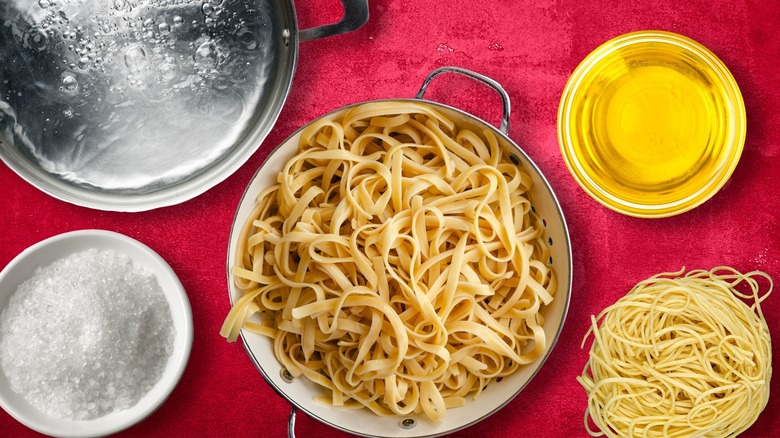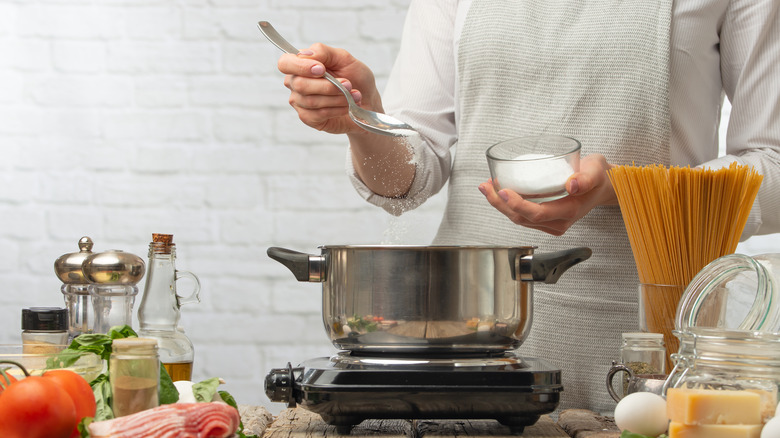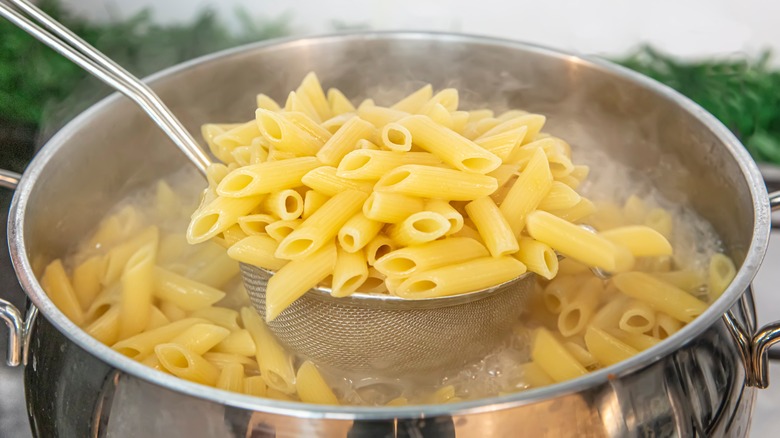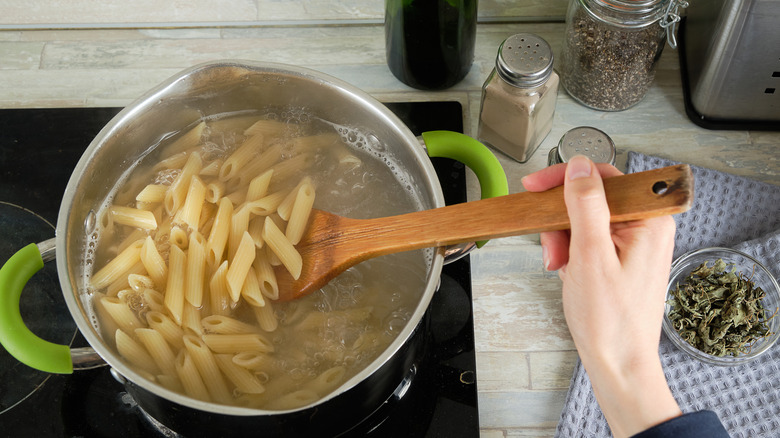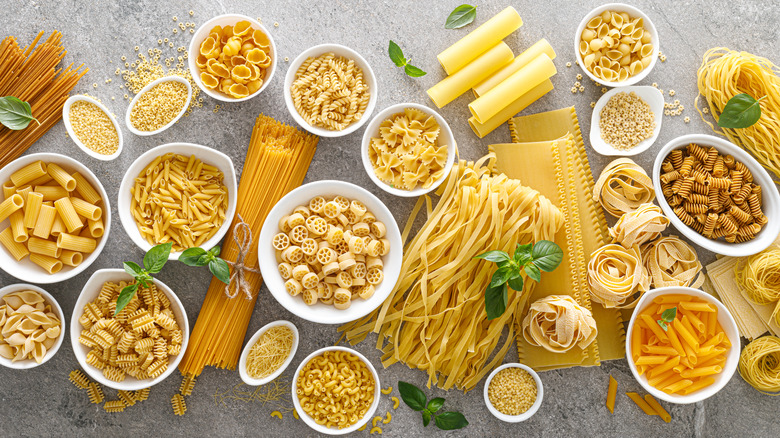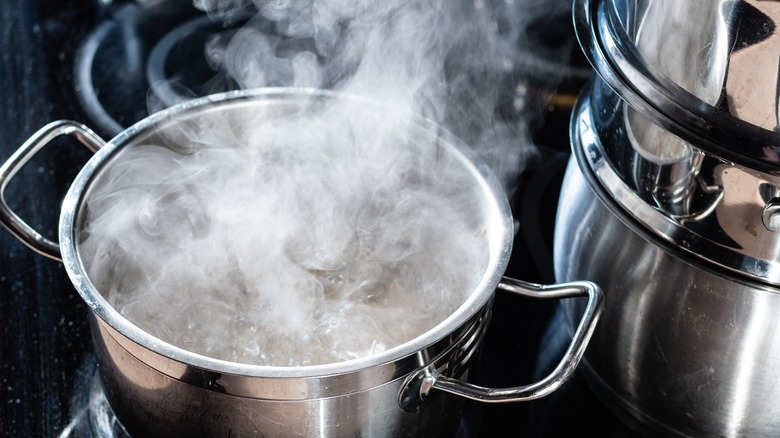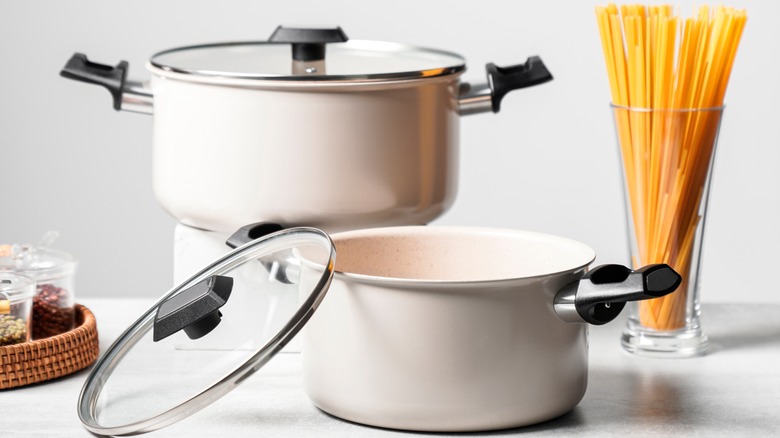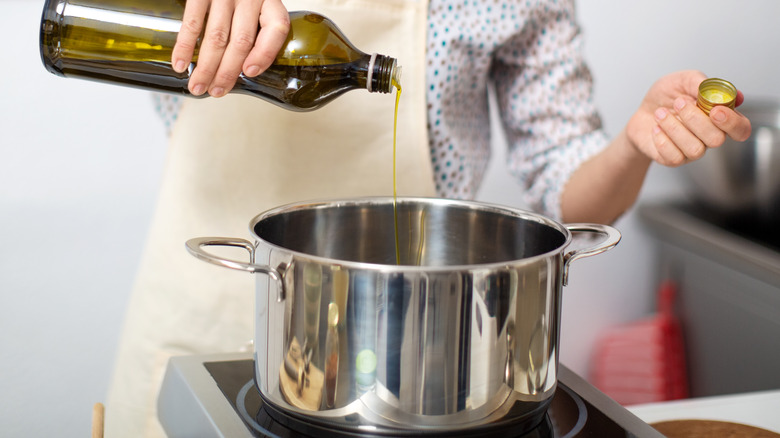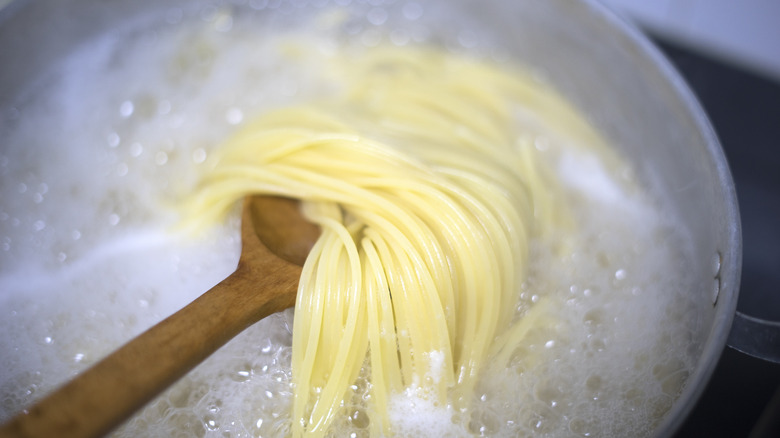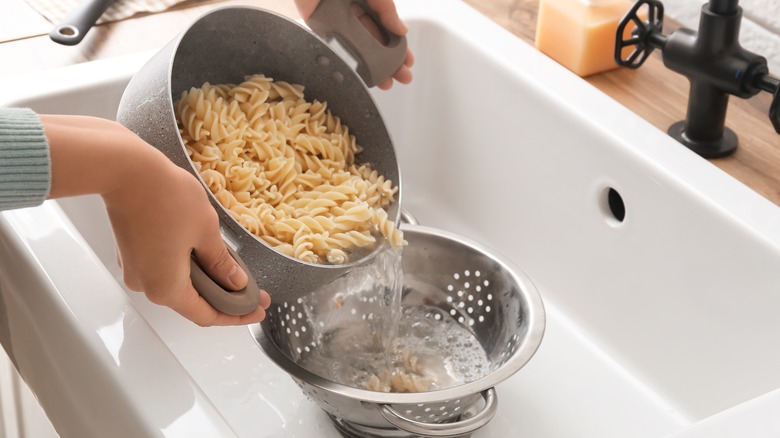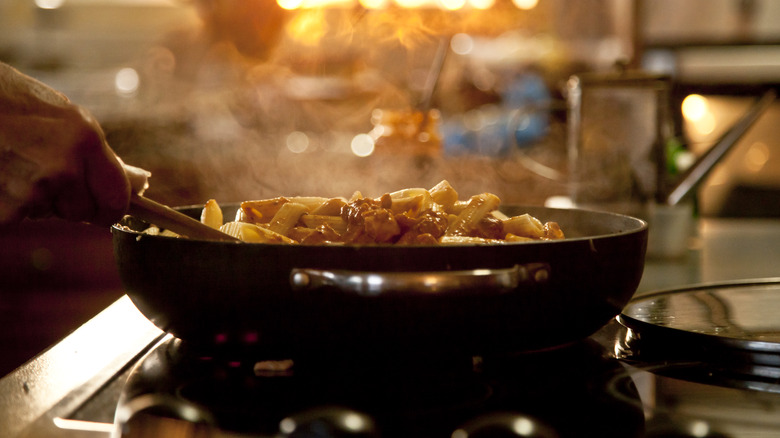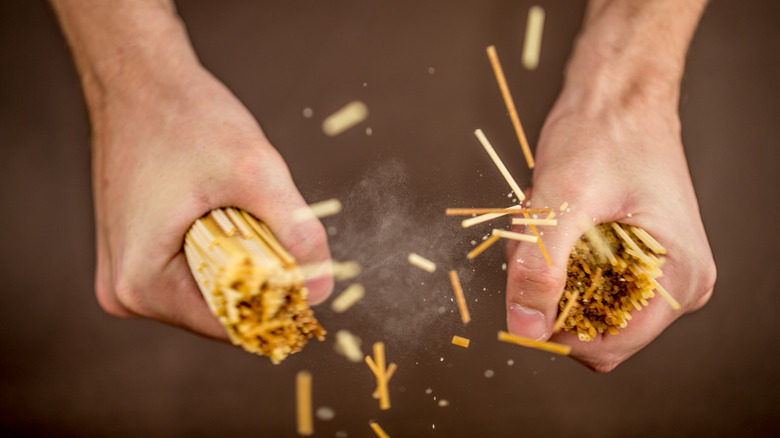11 Common Pasta Mistakes You Should Never Make
Pasta is one of those deceptively simple dishes. The directions seem straightforward. Just add dried pasta to boiling water, cook until tender, and enjoy! Easy right? But, so frequently, it goes wrong. That's because despite how foolproof pasta seems, there are a lot of common mistakes that both novice and well-seasoned cooks are guilty of making. Something as seemingly minor as cooking a minute too long, adding pasta at the wrong time, or using the wrong pot could make the difference between a magnificent Italian dinner and a disappointing meal.
Fortunately, once you know these mistakes, you can avoid them in your cooking. Chowhound spoke to skilled chefs about some of the most common pitfalls to look out for in your pasta-making. Whether you're guilty of making clumpy, mushy, crunchy, or bland pasta, they shared tips on how to avoid the problem going forward. Remember these mistakes so that the next time you make spaghetti and meatballs, alfredo pasta, or any of your other favorite dishes, you know how to make an Italian-chef-worthy pasta base.
Not properly salting the pasta
Salting pasta is a quick step that's easy to skip but makes a big difference. We all know that unseasoned food turns out bland and unappetizing, so it follows that salted pasta tastes better than unsalted. Just like you would add herbs and spices to your pasta sauce, it's also essential to season the pasta by salting the water you cook it in.
Do you add salt already? You may still be under-salting the water and missing out on the flavor potential. Chef Amy Hand, a food writer for The Skillful Cook website, told Chowhound it's important to be generous when adding salt to your pasta water. "You will use a lot of water when cooking your pasta so don't be shy and salt that water thoroughly," Chef Hand said. "It may seem like a lot, but the pasta itself will only absorb some of that salt in the quick cooking time, so it should not turn out too salty."
Lauren DeSteno, executive chef at Ai Fiori and an experienced pasta maker, said salting pasta water is a must. Her secret to determining the correct amount of salt to add is to wait for the pot to boil. "The salt dissolves immediately and you can tell very quickly if you need to add more or not," Chef DeSteno explained. If you add the salt to cold water it's more likely to settle on the bottom and ultimately lead to oversalting the pot.
Cooking pasta for too long or not long enough
Cooking pasta should be one of the easiest steps in preparing dinner. All you have to do is add the dry noodles to boiling water and cook until done, but that's easier said than done. You can ruin the dish if you get your timing wrong by even a minute. Cook the pasta for too short of a time and it will be too crunchy and chewy, but if you cook it too long, it will become mushy and fall apart under the sauce. To avoid this and get perfectly cooked pasta, Chef Lauren DeSteno advises setting a timer. The cooking time will vary depending on what kind of pasta you're making, but you can get an idea from the package instructions on your pasta box. Instead of following those instructions exactly, DeSteno said she sets her timer for 1-2 minutes less than the directions.
Unfortunately, cooking pasta isn't an exact science, so you'll still need to test the pasta before draining. "You can use a timer to measure the cooking process, but in the end, you must taste it to gauge the doneness," Nadia Minniti, an instructor at the Institute of Culinary Education and skilled Italian chef, told Chowhound. Minniti said she always taste-tests her pasta and even adds a few extra noodles to the pot so she doesn't alter the serving sizes by doing so.
Not using enough cooking water
The amount of water you use to cook pasta is essential. You may think you only need enough cooking liquid to cover your pasta, but this is incorrect. "Adding enough water to cook the pasta is another simple mistake I see home cooks make all the time," Chef Amy Hand said. "Pasta is very starchy, and this starch will leech into the water as the pasta cooks. If you don't have enough water, the water you have will become thick and almost sticky. This will result in pasta is that is unevenly cooked and sticks together very easily."
Fortunately, there's an easy measurement you can use to add enough water and avoid sticky pasta. "The average ratio of water to pasta is 4 to 1," Chef Nadia Minniti said. "For example, if you cook one pound of pasta, you will need four quarts of water." Stick to this golden ratio and you should have the ideal amount of water to cook your pasta without overcrowding the pot.
Using the same cooking technique for all pasta shapes
Pasta comes in many shapes and sizes, and ignoring these differences is a big mistake. "Each type of pasta will require a different cooking time based on thickness," Chef Nadia Minniti explained. "For example, angel hair cooks extremely quickly compared to rigatoni. Moreover, fresh pasta cooks much faster than dried pasta, usually within a few minutes or as soon as it floats."
Along with the shape of the pasta, Chef Lauren DeSteno said it's also important to consider the type of dish you're making. "If I am cooking a campanelle or rotini that is getting added to the sauce in a pan, I cook it a tiny bit less than other shapes," she said. "This is because the little spirals tend to break off these shapes when they are overcooked. Putting them in the sauce a touch undercooked helps to prevent that."
On the other hand, if you're making a cold salad where the pasta won't continue cooking in a sauce, it's better to boil the pasta until it is a little more tender before draining. Keeping the pasta's shape and thickness, and the type of dish in mind, you can taste-test and adjust your cooking time accordingly.
Not letting the water boil first
Cooking amazing pasta requires proper timing and order of operations. Instead of throwing the dry noodles and water into a pot and putting it all on the stovetop at the same time, you should wait for the water to boil before adding the pasta. While it may seem easier to start by combining everything and setting your timer, it will lead to many more problems in the long run.
Chef Amy Hand told Chowhound that this is one of the most common mistakes she sees home cooks making. "It's natural to be impatient, but having the water at a full rolling boil will ensure that your pasta cooks quickly and doesn't become waterlogged," she said. "The water will naturally cool when the cold, uncooked pasta is added to the pot, so if you add it too early, it's just going to take that much longer to come back up to heat."
Not waiting until you have a rolling boil will give your pasta an unpleasant mushy texture by the time it's done cooking because it will have been sitting in water too long. In a proper boil, the pasta will cook quickly and evenly to become al dente.
Using the wrong sized pot
You may think you can toss your pasta and water in any pot you have on hand, but using too small of a cooking vessel is a very common mistake. Giving your pasta ample room to cook is essential. In a small pot, it will be hard to add enough water and maintain the right cooking temperature. "The raw pasta will lower the temperature of the water, and if there isn't sufficient water in the pot, it will take longer to come back to a boil," Chef Lauren DeSteno said. "For regular pasta, this will make it take longer to cook, and the final resulting liquid will be very starchy. For something like a ravioli, this increases the likelihood that they will stick to each other or the bottom of the pot."
Even if you can add enough water to your too-small pot, you risk it overflowing once you add your pasta. You can avoid all of this by selecting a large pot with tall sides that can easily hold the liquid and pasta with a little space to spare. Or, consider avoiding this problem altogether by skipping the pot and making pasta quicker in your frying pan.
Adding oil to pasta water
Too often, people (and sometimes even chefs) recommend adding a splash of olive oil to pasta water. The supposed benefit of this is to keep your pasta from sticking together, but it's a mistake. "What you absolutely do not want to do is add oil to the water because this prevents the sauce from sticking to pasta," Chef Nadia Minniti explained. Whether you're preparing a white or red sauce, cooking the noodles in oil will give them a slimy texture that the sauce will slide off of instead of clinging to.
On top of that, olive oil is an excellent ingredient that is better savored. Italian chef and content creator Vincenzo Prosperi was offended by the idea of wasting olive oil in cooking water. "Why do you waste the extra virgin olive oil in the pasta water? Never, never, never waste the extra virgin olive oil," he said in a video on his YouTube channel, Vincenzo's Plate. "First, because it's expensive," he said. "Second because you don't waste it like that. It's such a beautiful, beautiful ingredient. It's the best ... oil for you to eat, you don't waste it in water okay?" Instead, save your oil to drizzle over your cooked pasta or add it to bread for an authentic Italian dinner.
Not stirring the pasta
Once you've gotten your ingredient ratios right, have brought the water to a boil, and added the pasta, your work still isn't quite done. Because pasta is such a simple dish on the surface, it's easy to overlook essential parts of the cooking process, including the need to stir your noodles. Chef Lauren DeSteno said skipping this key step is one of the most common mistakes she sees people make.
The starchy nature of pasta leads to a sticky texture. So, if you don't separate the noodles, they can easily clump together throughout their cooking time. According to DeSteno, stirring is especially necessary for long pasta like spaghetti and linguine to avoid them sticking together and making a tangled mess.
Interestingly, sticky, clumpy pasta is exactly what many cooks are trying to avoid when they add oil to the pasta. But instead of wasting oil, you can simply stir the pot as soon as you add your pasta to the boiling water, and repeat periodically until the pasta is separated and well-cooked.
Throwing out the pasta water
Even after you've added enough water, salted, and cooked the pasta to perfection, you can still stumble at the finish line. When draining the pot of noodles, plenty of home chefs throw everything in a colander and let all the cooking water drain down the sink, not knowing they are wasting an ingredient. While you may think the water has done all it can and is just food waste, that is far from true. Chef Lauren DeSteno said you should set aside some of the cooking water to use when you add the pasta to the sauce. The cooking water is an excellent emulsifier and thickening agent for rich and silky pasta sauce.
The water has this effect because it absorbs starch from the noodles as they cook. Because of this, substituting fresh water for pasta water won't have the same effect as it doesn't contain the same starchy qualities. This is why many chefs call pasta water "liquid gold." While you don't need to save the whole pot of water, setting aside a cup or so is a great way to upgrade your marinara or bolognese sauce. There are plenty of uses for the starchy water, so don't make the mistake of throwing it all out.
Not taking advantage of par-cooking
Instead of cooking your pasta in plain water the whole time, you can add more flavor by finishing it in pasta sauce. The pasta will continue to cook in the sauce, absorb extra flavor, and add some starchy liquid to the sauce. This is an excellent way to take a simple pasta recipe and make it into a restaurant-worthy meal.
Chef Lauren DeSteno recommends par-cooking (partially cooking) your pasta ahead of time and then finishing it in the sauce. "This is particularly helpful for, for example, a dinner party or large group of people," she said. "With this method, you don't have to worry about standing over a steaming pot. When ready, just add the par-cooked pasta to the sauce and finish cooking. Just remember, the pasta will absorb a good deal of liquid from the sauce, so make sure you have extra sauce or liquid to compensate."
You can also try cooking pasta in other types of liquid besides water or sauce. Using broth or stock is great if you're using pasta in a soup. Milk can be a delicious cooking liquid for a creamy pasta recipe, and cooking in wine can be an excellent flavor enhancer.
Breaking long pasta to cook
To make long pasta like spaghetti, angel hair, and fettucini fit in the pot, you may be tempted to snap the pasta in half. It seems like a harmless trick to make life easier, but there are many reasons why you should think twice before breaking long pasta. "In Italy, pasta is never broken, especially spaghetti," Chef Nadia Minniti said, adding that an Italian chef would never break pasta and doing so is a dead giveaway that the cook isn't Italian.
Chef Amy Hand added to this, explaining, "The reasoning for this is that you have chosen this pasta shape — fettuccini, linguine, spaghetti — for its length, so breaking it defeats the purpose of choosing a long pasta." Long noodles are made to be twirled on your fork and in the sauce; you can't do this if you break the noodles into pieces as the broken noodles are harder to pick up. If you don't want long noodles or don't need them for your recipe, you can always use a different type of pasta and avoid the problem entirely.
